Boost your site’s visitors and ranking with the ultimate on page SEO checklist I’ve compiled for you.
I’ve been in the SEO field for a while now, and what I’ve learned so far is that if you want to have your SEO in place, one of the most important things to check is On-Page SEO.
This is why I created this list – I personally use it whenever I’m about to publish a new article to make sure everything is in place.
This on-page seo checklist covers 9 checks you can do before hitting that publish button.
Plus, every point on this on-page SEO checklist comes with an explanation of how to meet the requirements. It’s super helpful when you realize you’ve missed something but don’t know how to fix it.
Rest assured, with this checklist, you’ll never have to worry about any on-page SEO concerns that might be holding you back from getting actual visitors and rankings.
What is the On-Page SEO checklist for 2024?
- Keyword Relevance and Placement
– Did I include all the relevant keywords?
– Did I put them in the right places?
– Did I overload the content with keywords? - Multimedia Optimization
– Have you compressed the images?
– Have you added a descriptive ALT text?
– Did you give the image file a descriptive name?
– Have you included relevant keywords in the ALT text and file name? - Content Optimization
– Have you added high-quality, relevant content to your niche?
– Have you followed Google’s EEAT Guidelines? - Internal Linking
– Have you internally linked related/relevant posts? - URL
– Is your URL descriptive?
– Have you inserted your primary keyword? - Meta Description tag and Title tag
– Did you include catchy Meta tags?
– Does the title contain the target keyword? - Page Speed
– Have you checked the page speed? - Mobile Optimization
– Have you optimized your website for mobile devices? - Headings
– Have you organized your titles in a clear hierarchy?
1) Keyword Relevance and Placement
The first item on this on-page SEO checklist concerns keyword relevance and placement.
These are the checks I always do:
- Did I include all the relevant keywords?
- Did I put them in the right places?
- Did I overload the content with keywords?
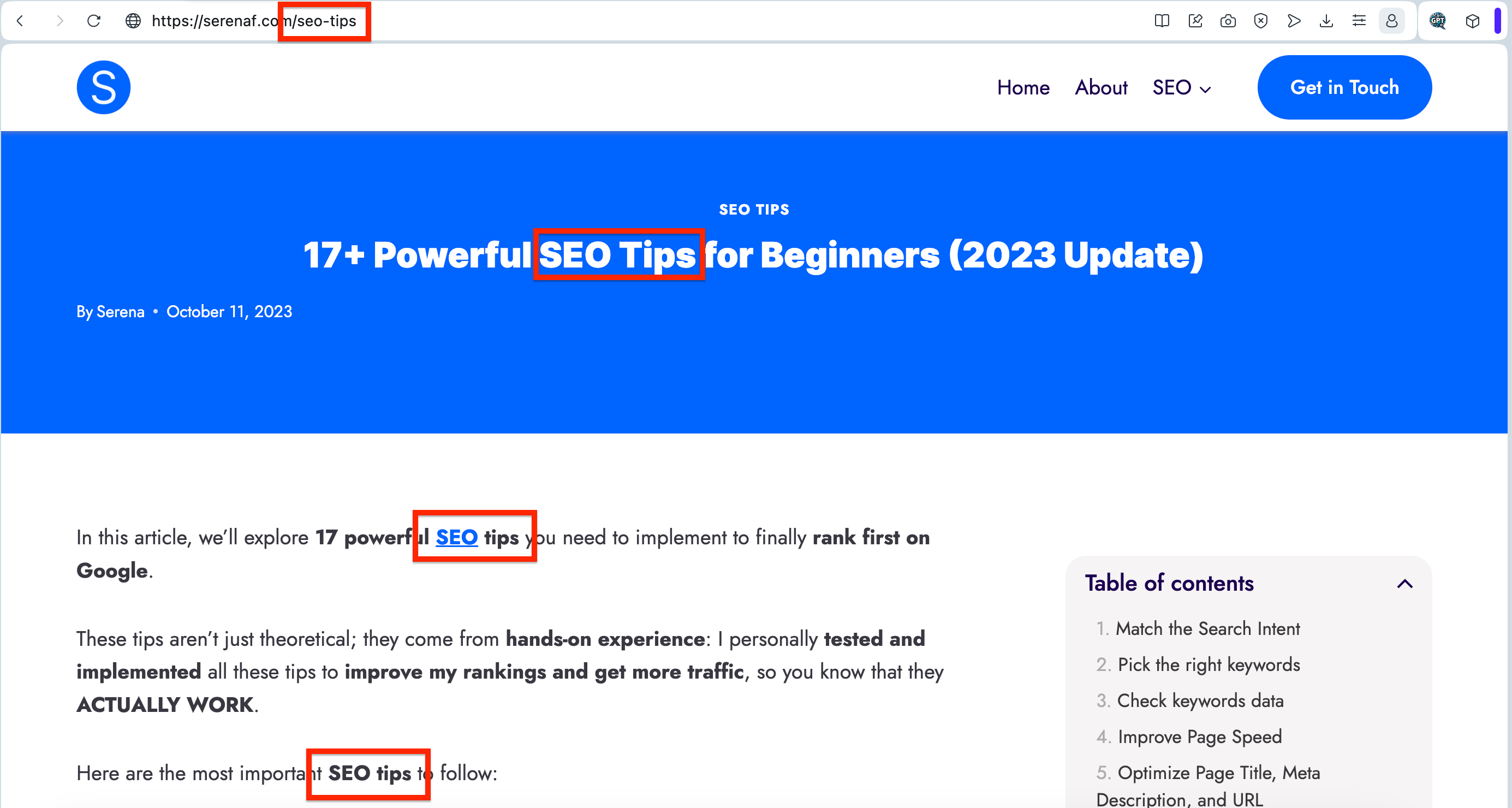
Keyword Relevance
To help your readers grasp the topic better, make sure to include relevant keywords (primary keywords and semantically related keywords) in your content.
These keywords should be natural and seamlessly integrated into the text.
For instance, let’s say you’re writing a blog post on “how to do link building for SEO.” You would naturally incorporate related terms like “external links,” “SEO strategy,” and “link-building tools.”
When you do this, your content becomes more engaging, and search engines can easily understand the main and related topics of your blog post.
As a result, Google will prioritize your article whenever it receives relevant queries, ensuring it ranks higher in search results.
Keyword Placement
When it comes to inserting target and semantically related keywords, their placement is crucial.
Here are some key spots:
- URL
- Headings (H1 tag, H2 tag)
- First 100 words of the page
- Meta descriptions
- Alt text
Avoid Keyword Stuffing
Avoid keyword stuffing and keep it natural.
If you overdo it, your readers will notice and leave your site.
Imagine this: you come across a text that seems like it’s written by a machine – no emotions, no natural language.
It’s packed with words that just don’t fit the context. What do you do? You’d probably click away, right?
Well, here’s the thing: search engines are smart enough to detect these unnatural patterns and penalize your site for it.
2) Images Optimization
The next item of this on-page SEO checklist concerns Image optimization.
It’s easy to forget this step (trust me, I’ve been there too).
Before you hit that publish button, let’s quickly go through these checks:
- Have you compressed the images?
- Have you added a descriptive ALT text?
- Did you give the image file a descriptive name?
- Have you included relevant keywords in the ALT text and file name?

Image Compressor
Did you know that you can automatically compress your images with plugins?
Use these plugins to make your web pages load faster. They shrink, resize, and even lazy-load your images (loading them only when needed).
Some WordPress plugins that serve this purpose are Smush, Ewww.io, and Optimole.
Add ALT texts
Add descriptive ALT texts to all your images.
These texts not only help search engines crawl and rank your site but also allow screen readers to describe the image to visually impaired readers.
How to write an ALT text?
Describe the image exactly as it is. Be specific about what it shows and avoid using phrases like “Image of…” or “Picture of…”.
Good and Bad Examples of Alt Texts
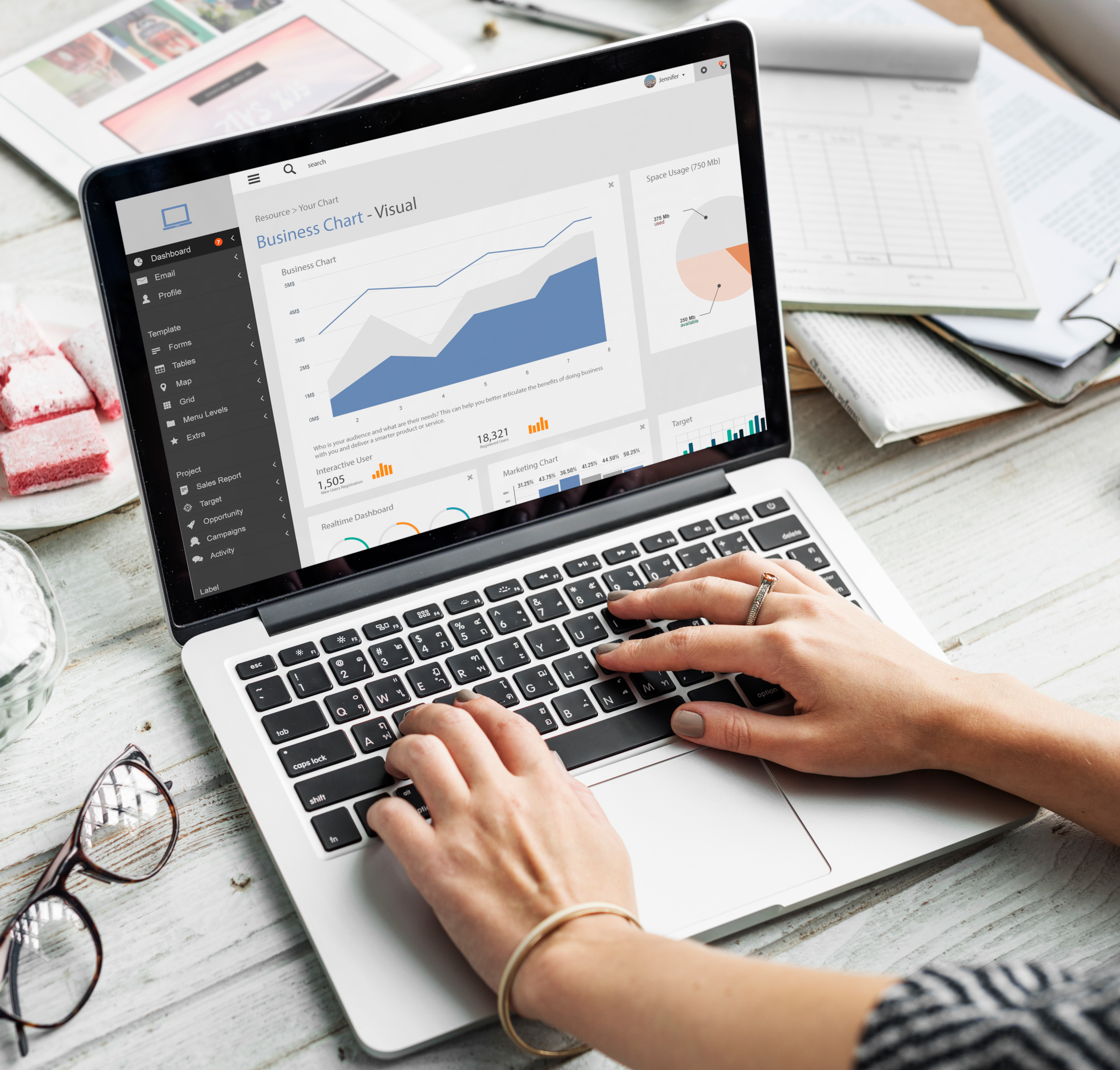
Bad Example
Alt=”Image of a laptop and a person’s hands.”
Good Example
Alt=”A Person writing on a laptop showing a business chart on its screen.”
Insert a descriptive image name file
The image’s file name should be descriptive, just like the ALT text.
Use specific words that clearly describe the image. Avoid using unrecognizable file names like “6bcd7375-9f41-49a0-bda1-896d94f28696.png”.
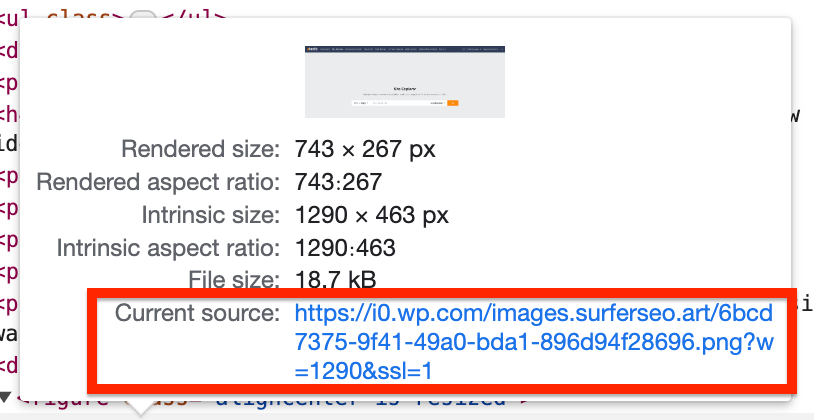
Insert Keywords in your ALT text and file name
Include relevant keywords in both the alt text and file name.
This not only makes the images a ranking factor but also helps optimize their visibility.
However, it is important to incorporate these keywords in a way that fits the image context naturally.
Avoid forcing keywords if they don’t align with the image content.
3) Content Optimization
- Have you added high-quality, relevant content to your niche?
- And have you followed Google’s EEAT Guidelines?
Content Quality & Relevance
To have a good SEO strategy, the key is to provide value to your target audience.
Makes sense, right?
If you spend time creating content that is informative, useful, engaging, and shareable, you’re more likely to attract more traffic, and users will end up spending more time on your site.
This good habit isn’t just good for getting more traffic.
It’s also great for backlinks and improving the overall user experience on your website.
Plus, the more relevant your content is, the more your website increases its topical authority.
Google’s EEAT
Google wants you to demonstrate “EEAT” – Experience, Expertise, Authoritativeness, and Trustworthiness.
According to Google’s content guidelines, the more your content showcases these qualities, the better chance you have of appearing on the first page of Google.
This indicates that Google trusts your content and believes it can be valuable to readers.
And the more your content appears on the first page of Google, the more traffic you’ll receive.
4) Internal Linking
- Have you internally linked related/relevant posts?
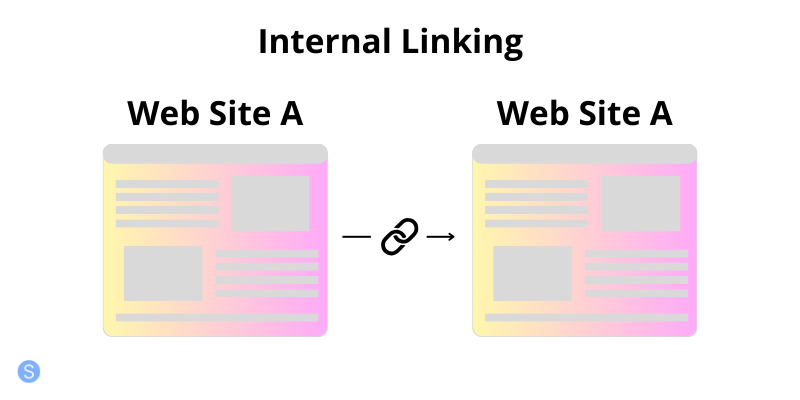
Internal linking improves user experience and topical authority.
When you strategically insert internal links, you’re telling search engines that these pages are essential in supporting your main content and improving crawl efficiency.
And guess what? The link juice flows through these internal links, benefiting other subpages within your site.
5) URL
- Is your URL descriptive?
- Have you inserted your primary keyword?

Descriptive URL structure
The URL structure should be descriptive, and it should contain your primary keyword.
Here is what to avoid:
- Underscores and spaces to separate words
- Capital letters
- Numbers or Dates
Here is what you can do:
- Dash symbol “-” to separate words and to make your URL more readable
- Lowercase letters
Your URL should consist of words that remain stable over time.
For example, instead of “8-link-building-tools-of-2023”, consider “top-link-building-tools”.
This way, as you update your content over time or add new items, you won’t risk losing valuable backlinks due to URL changes.
Imagine this: another website links to your article “8-link-building-tools-of-2023”, but the year you update the article and change it to “8-link-building-tools-of-2024”.
You’ll lose the backlink, and the site owner will end up with broken links.
6) Meta Description tag and Title tag
- Did you include a catchy Meta description?
- Does the title contain the target keyword?
Meta description

Crafting compelling meta descriptions has the power to increase your click-through rate (CTR).
How do you create good meta descriptions? Follow these simple rules:
- Keep it concise – aim for 130-160 characters.
- Include your target keyword.
- Provide clear and specific information about what the article offers.
Title tag

The title tag is a key element for search engines to understand your page’s content and motivates users to click and visit your page.
How to Write Title Tags That Actually Work?
- Keep them Brief
- Be creative: write a unique title tag that encourages users to click.
- Insert your target keyword.
- Insert a number and/or date. Spark curiosity with odd numbers and show that the article is updated with fresh information. For example, “7 Ways to…” is more intriguing than “10 Ways to…”.
What to Avoid?
- Avoid long titles that get cut off by the browser (this can significantly affect your rankings).
Have you ever noticed that whenever there is a title tag that is too long, Google automatically cuts it off and adds “…”?
Check out the image below:

How to check if your titles and meta descriptions are the right size?
There are online tools like Mrs Digital+ that make it super easy. Just input your title information, company name, URL, and meta description, and voila!
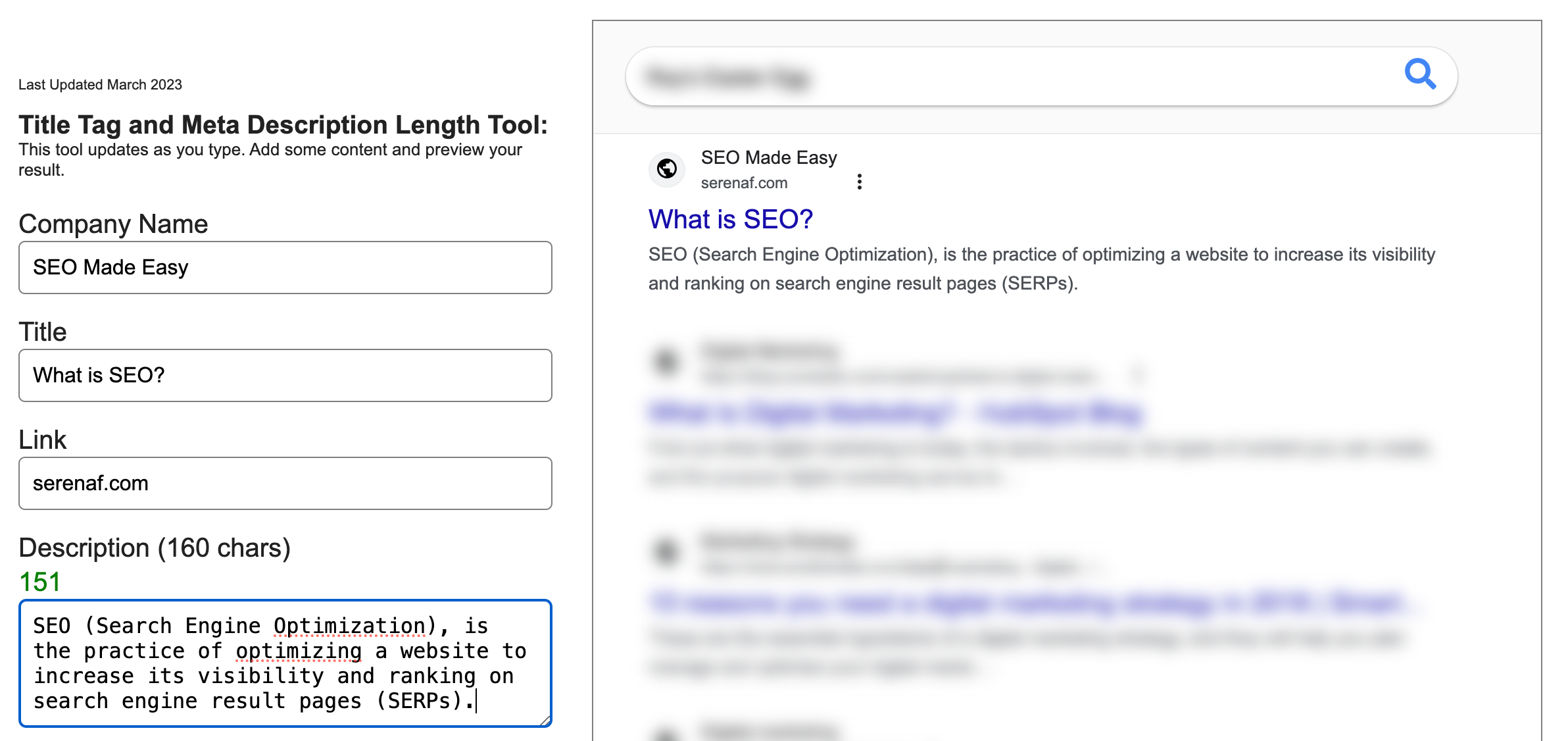
7) Page Speed
- Have you checked the page speed?
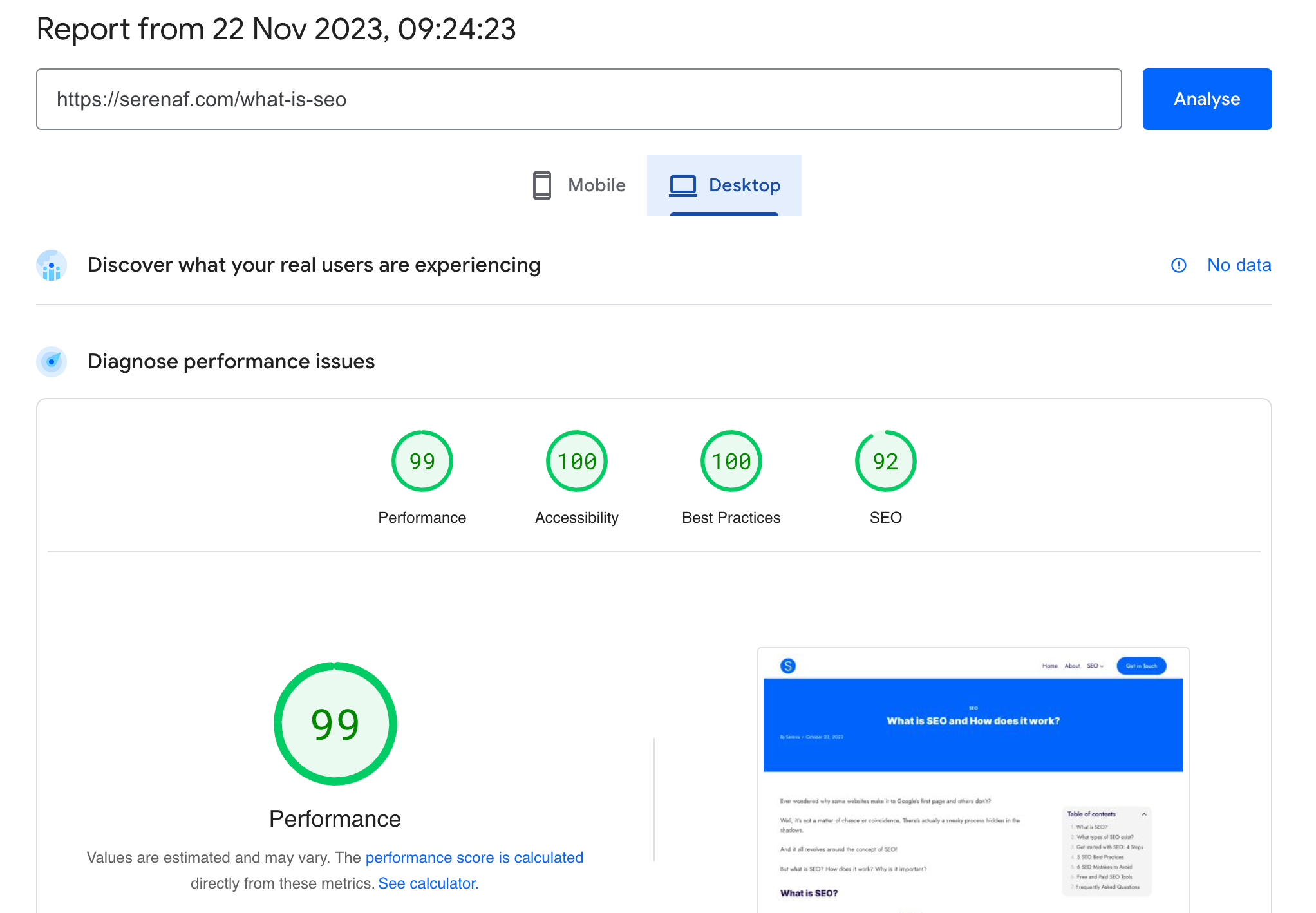
Did you know that page speed plays a crucial role in search engine rankings?
According to Google, the chances of users bouncing from your site increase by a staggering 32% when your page load time goes from 1 second to 3 seconds.
So, the faster your site loads, the better your chances of ranking higher and keeping your audience engaged.
To check your page speed, you can use the Free tool PageSpeed Insights.
How can you improve your page speed?
There are several tools and WordPress plugins available, such as WP Rocket, that optimize your page CSS and JS, preload content, and adjust media dimensions to enhance your page performance.
8) Mobile Optimization
- Have you optimized your website for mobile devices?
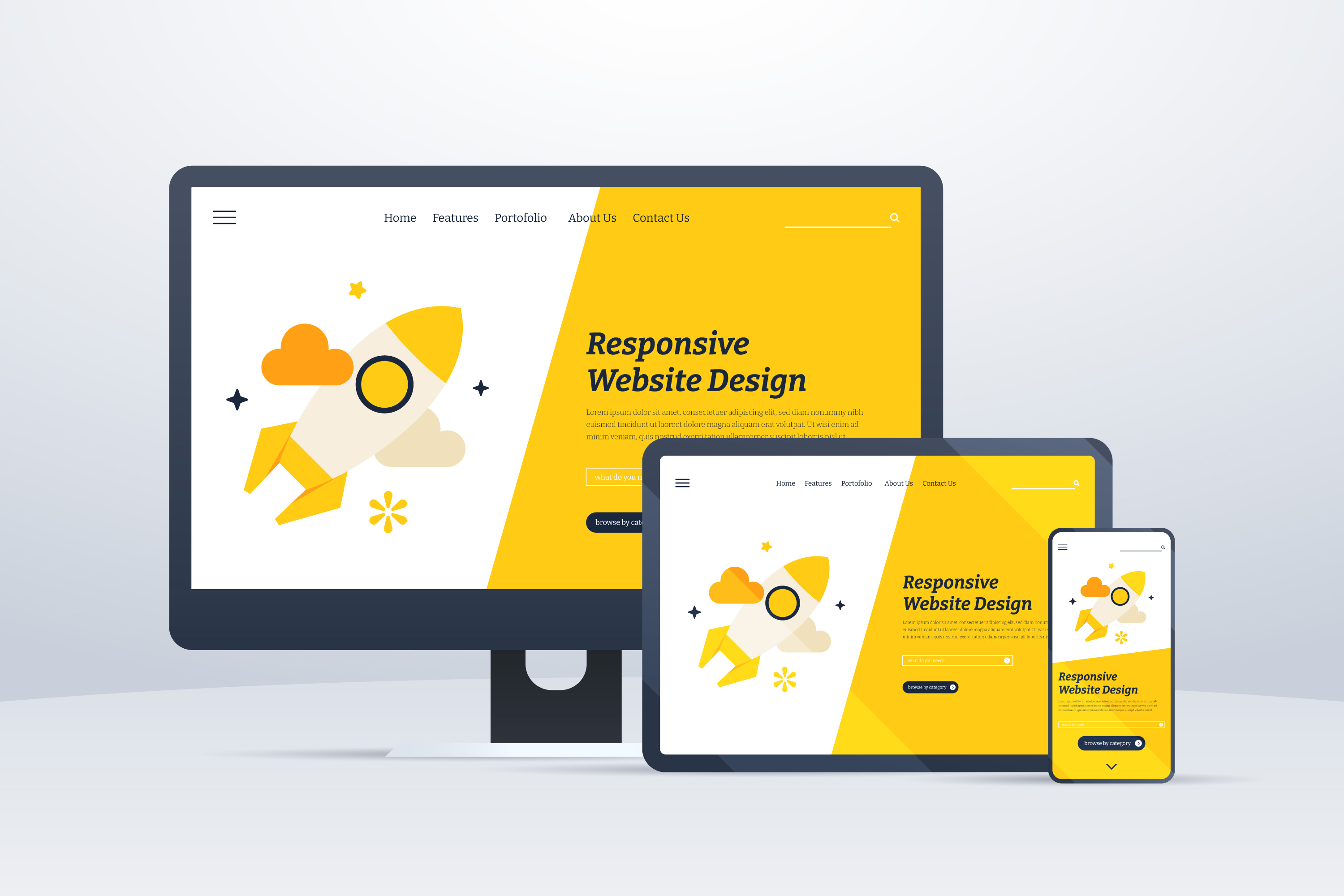
Another important check for this on-page SEO checklist is Mobile optimization and Responsiveness.
If your website isn’t optimized for mobile, users are likely to leave, causing increased bounce rates and negative impacts on SEO.
Several mobile optimization Statistics reported by Hubspot show how important it is to optimize content for mobile.
How can you optimize your web page for mobile phones? Here are a few key steps to follow:
- Make your mobile site responsive: Ensure it adapts to different devices, eliminating the need for users to zoom in or out.
- Remove unnecessary decorative text or images that take up valuable space.
- Insert images and graphics of the appropriate size to ensure fast loading times and optimal user experience.
- Keep an eye on your mobile speed by using tools like PageSpeed Insights to identify and address any potential performance issues.
9) Headings
- Have you organized your titles in a clear hierarchy?
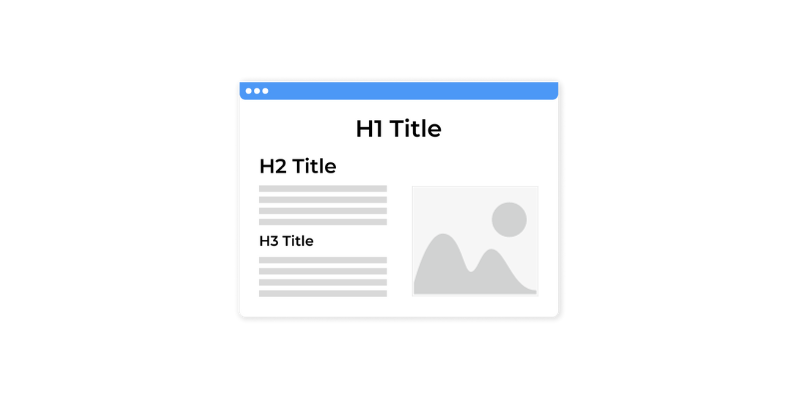
To help users quickly find the information they need and for search engine crawlers to understand your webpage’s main topics, it’s crucial to insert titles with proper hierarchy.
How do you insert title tags correctly?
- Start with an H1 tag, ensuring you have one and only one.
- Hierarchically insert H2, H3, and H4 title tags to structure your page effectively.
What Is On-Page SEO?
On-page SEO (Search Engine Optimization) is the practice of optimizing the elements that can be found inside a web page to make it more appealing to search engine crawlers and ultimately improve its visibility on search engine results pages (SERPs).
What elements should be optimized?
- Keywords
- Internal Links
- Page Structure
- Page Speed
- Images and Videos
Frequently Asked Questions
On-Page SEO vs. Off-page SEO
On-page SEO focuses on optimizing the elements within a webpage itself, such as content and HTML code.
Off-page SEO refers to actions taken outside of the website to improve its search engine rankings, such as building backlinks and social media marketing.
What are the Best On-Page SEO tools?
The best On-Page SEO tools are:
- Ahrefs: to find the best keywords for your content, products, and services
- Surfer SEO: to write keyword-optimized content
- Google Search Console (Free): To monitor your website performance
- Screaming Frog (free): To audit your website






[…] On Page SEO refers to all the on-site actions you can do to boost your rankings on search engines like Google. […]
[…] On-Page SEO: Insert your target keyword in a few key places – the URL, title, meta description, and throughout the content. On page elements help search engines know what your page is about and help them index your landing page for the appropriate queries. […]